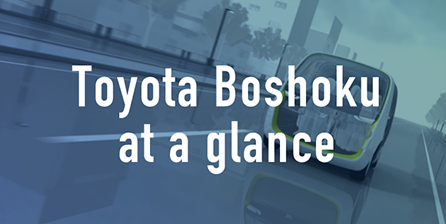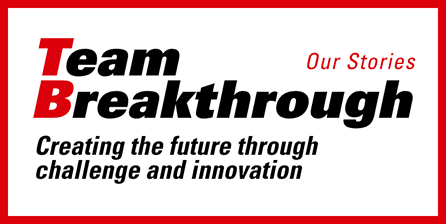Safety
Our Basic Philosophy for Safety and Health, and Our Basic Safety and Health Policy
Based on a Basic Safety and Health Policy, the Toyota Boshoku group implements health and safety activities as labor-management cooperative efforts in order to establish a corporate culture that places priority on health and safety at work. We also work globally to enhance health and safety at work through activities based on an Occupational Safety and Health Management System (OSHMS). Furthermore, in order to absolutely prevent the occurrence of fires, we conveyed Toyota Boshoku’s stance on fire prevention and conducted management-led inspection in each area, held emergency preparation drills using fire extinguisher and fire hydrants for all members, and worked to raise awareness towards fire prevents.
Basic Philosophy for Safety and Health
Safe work
Reliable work
Skilled work
Safe Work is “the gate” to all work
Let us pass through this gate
Basic Safety and Health Policy
To foster a “Safety First” culture, we declare that we will not produce, handle, transport, or dispose of products or materials unless people’s safety & health, and the environment are protected. Additionally, we will conduct ourselves in line with the following basic principles.
Shuhei Toyoda
Policies for Safety Management
- Don’t hesitate to stop producing.
- It is impossible to produce without the solution of the safety problem.
- Accident has to be “Zero” even if it is non-absence accident.
- Safety is at the basis of the workplace.
Health and Safety Promotion System
We have established a group-wide health and safety promotion system to build a “safe and comfortable workplace environment,” by formulating and following through on health and safety goals for the Toyota Boshoku group.
Health and Safety Promotion System

Health and Safety Activities Index
Number of work-related injuries at Toyota Boshoku group
| Total scope | Fiscal year | ||||||
|---|---|---|---|---|---|---|---|
| 2021 | 2022 | 2023 | 2024 | 2025 | |||
| All accidents (Cases) | Toyota Boshoku group | 76 | 95 | 134 | 114 | 110 | |
| Toyota Boshoku | 11 | 13 | 16 | 20 | 21 | ||
| Fatal accidents on company premises (Cases) | Toyota Boshoku group | 0 | 0 | 0 | 1 | 0 | |
Lost time injury frequency rate (Lost time or more severe)*1

Occupational accident severity rate*2

- (Number of deaths and injuries due to occupational accidents / total number of actual working hours) x 1,000,000
- (Total days of lost labor/total number of actual working hours) x 1,000,000
- (Target for both *1 and *2 is Toyota Boshoku group permanent employees, employees under non-regular contract, associate employees, part-time employees, fixed-term contract employees, trainees employees, secondees, interns, and temporary staff (staff employed by the staffing agency))
Safety Commendations
By evaluating and recognizing the efforts of Toyota Boshoku and its affiliates inside and outside Japan, we aim to raise safety awareness and maintain motivation in our activities.
Commendation is made annually to outstanding companies based on an evaluation of the duration of accident-free periods in plants, the frequency of occupational accidents and total working hours, etc.
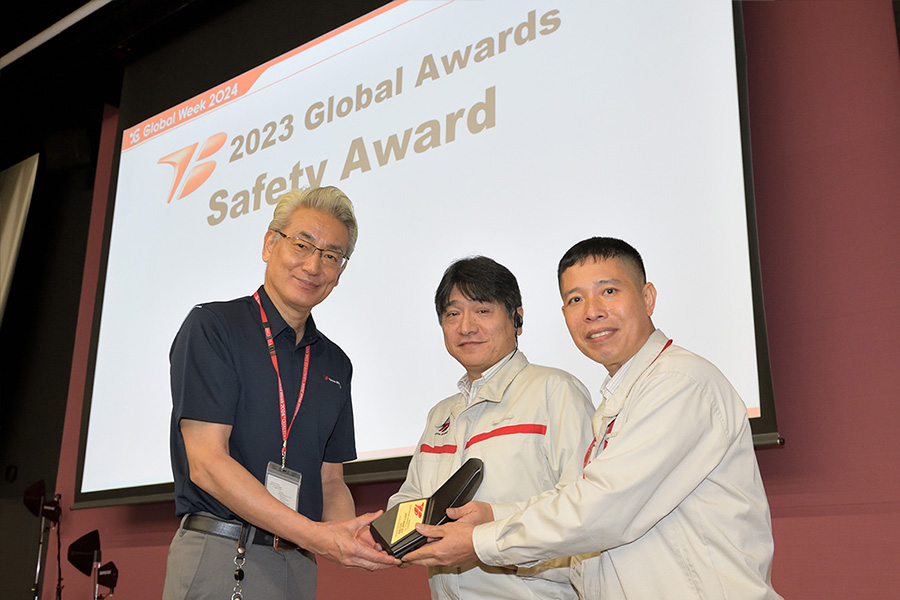
Promotion of Occupational Safety and Health Management System (OSHMS) Activities
Based on a Basic Safety and Health Policy, in order to establish a corporate culture that places priority on health and safety at work, the Toyota Boshoku group is continuing labor-management consultations and cooperative efforts aimed at building a pleasant working environment that guarantees the health and safety of company members.
In accordance with ISO 45001 standard requirements and Occupational Safety and Health Management System legal requirements, we have established the Toyota Boshoku Occupational Safety and Health Management System (Toyota Boshoku OSHMS). And we built a unified, more efficient Occupational Safety and Health Management System, and announced it globally. We grasp occupational health and safety issues and secure both human and financial resources to improve both health and safety at workplaces.
Building a Safe Working Environment
Using risk assessment (machines & equipment, chemical substances, work) to build an environment that is kind to workers
As part of Toyota Boshoku’s Occupational Safety and Health Management System, we have introduced risk assessments for machines and equipment, chemical substances, and work operations, based on government guidelines regarding harmful or dangerous substances. As a result, we are identifying possible sources of risk throughout the various steps of our manufacturing process design and taking measures to limit such risks to within acceptable limits, while enacting appropriate measures to manage any risks that remain. Additionally, when installing new machines and equipment, company members with responsibility for production engineering, manufacturing, maintenance and safety make visits to the relevant manufacturers. We then perform checks based on the findings of previous risk assessments, while at all times carrying out uncompromising safety measures.
These risk assessments are performed not only for the benefit of our company members, but also to address any possible risks that may be encountered by visitors or business partners. Finally, we are also performing appropriate health hazard prevention in relation to conditions and quantity of all harmful chemical substances used in our production processes.
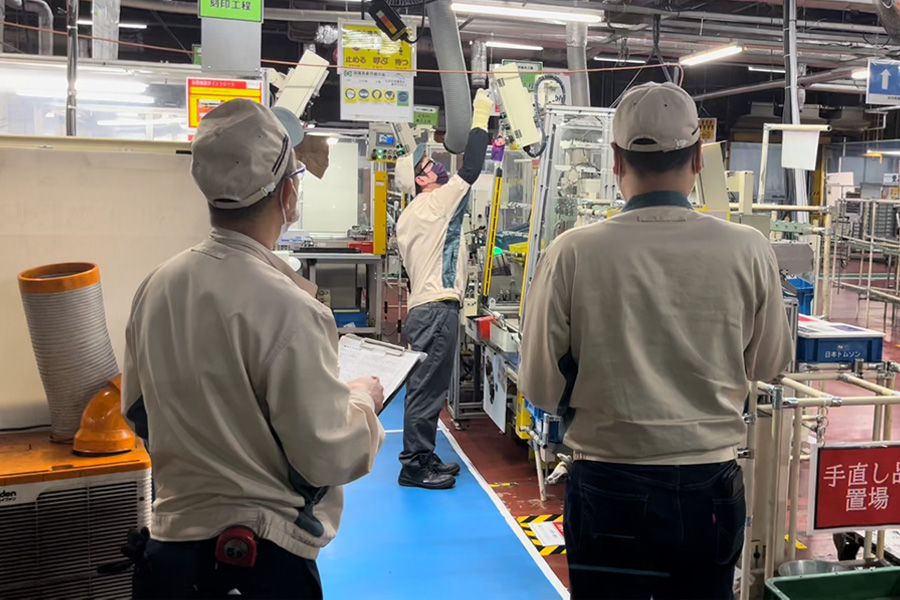
Safety and fire prevention cross-check
The entire group, including suppliers, continues to work together to prevent STOP6* accidents which may lead to fatal accidents and to prevent total-loss fires.
In fiscal 2025, as in previous years, a safety and fire prevention cross-check by top management of each plant was implemented globally.
Entity top management visits entities not under their jurisdiction to check items such as the status of 4S Seiri (Sort), Seiton (Set in order), Seiso (Shine) and Seiketsu (Standardize), to verify the environment for the practice of Stop, Call, and Wait, and to check safety measures at facilities, etc.
- Safety TOYOTA 0 (Zero Accident) Project 6: Toyota Motor's classification of past accidents in the automotive industry into six categories (1. Moving machinery 2. Heavy objects 3. Vehicles 4. Falls 5. Electric shock 6. Fire).

Global safety and fire prevention inspections by functional divisions
Members of the Health & Safety Center visit entities outside Japan to conduct safety and fire prevention inspections. They point out equipment malfunctions and unsafe operations, and promote improvements.
In fiscal 2025, we inspected 9 entities in the Americas, 10 entities in China, 17 entities in Asia, and 7 entities in Europe & Africa.
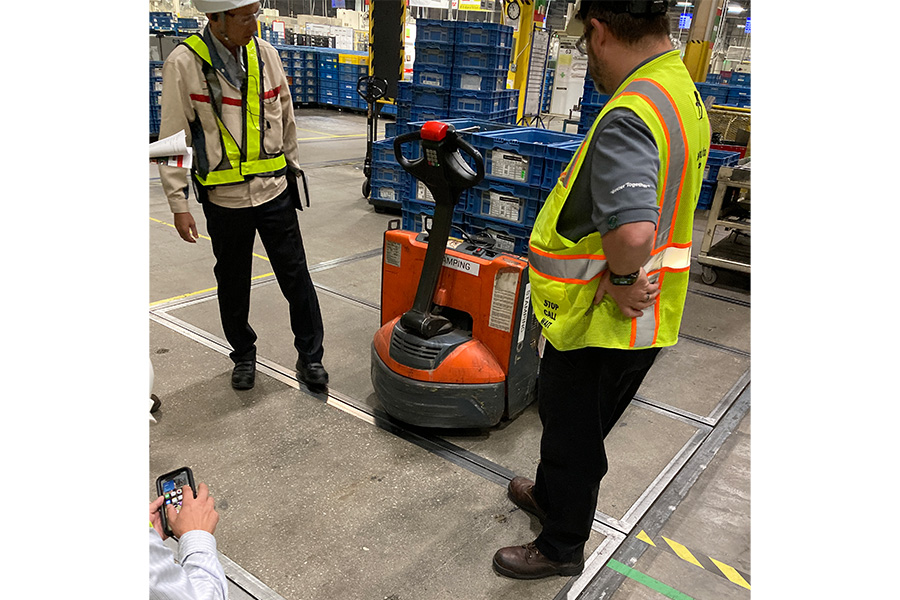
Safety Education
We believe that education is a key to safe behavior.
In order to promote the development of safe human resources and workplaces in which fatal accidents never occur, the Toyota Boshoku group is systematically implementing relevant activities on a global scale, such as enhancing education for acquiring knowledge and skills, holding safety inspections, and conducting activities to entrench a culture of risk assessment.
Main health and safety-related training programs and the number of participants
| Training content | Total scope | Fiscal year | ||||
|---|---|---|---|---|---|---|
| 2021 | 2022 | 2023 | 2024 | 2025 | ||
| Safety manager training participants | Toyota Boshoku | 43 | 67 | 53 | 62 | 96 |
| Group leader training participants | 50 | 0 | 97 | 47 | 52 | |
Developing human resources who can take Safety Basic Behavior
In addition to preventing occupational accidents, we are working to establish a “culture of taking things for granted” by having company members observe and follow the established rules in terms of manners and morals. For instance, we are continuously implementing “Poke-Te-Na-Shi Activity*” common to the Toyota group, raising the level of awareness by calling out to company members through Poke-Te-Na-Shi checks and poster contests, and creating workplaces where mutual enlightenment can take place.
- Five basic safety guidelines to prevent accidents while walking, including keeping hands out of pockets, and avoiding using one’s phone while walking

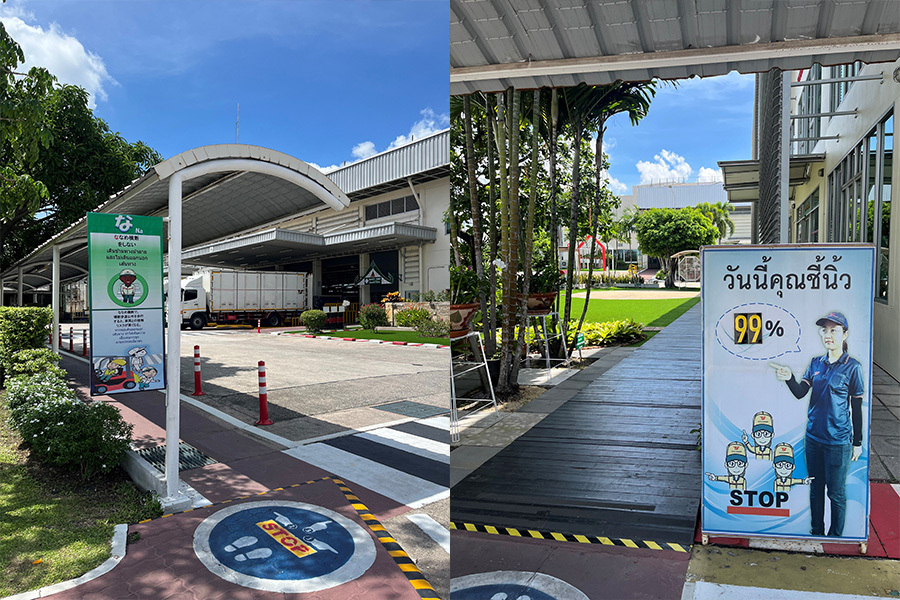
Renewal of Safety Act Center
Moreover, in fiscal 2021, we established Safety, Health, Environment fruitful Think and Act Center (SHE-TAC) within the MONOZUKURI Innovation Center with the aim of promoting the development of human resources who know the background and causes of past occupational accidents, consider countermeasures, take individual responsibility for matters of safety, and take initiative to implement preventive measures. SHE-TAC has continuously fostered the development of safety and accident prevention-focused company members, providing training at various levels, including for newly-hired and newly-promoted company members, as well as for members at affiliates in Japan.
From fiscal 2026, the scope of the trainees has been expanded and the name has been renewed as Safety Act Center. In-house safety personnel serve as instructors for the three courses (administrative, engineering, and manufacturing), each of which provides training on past cases of accidents, risks of accidents, and items that must be observed to prevent accidents. With regard to accident risk, to develop human resources capable of perceiving hazards as risks, all participating members of the training program, including instructors, conduct hazard prediction to identify which risks are present.
A total of 7,168 people (7,048 from Toyota Boshoku and 120 from affiliates, business partners, etc.) have participated in the program since its establishment.
Comments from participants
- There were many accidents that I did not know even though they were serious. It was a good opportunity to strongly realize how scary an accident can be.
- Seeing many cases, I realized that if I was not careful, I might cause serious injuries or accidents. So I was also able to alert people around me.
- The horror of accidents was clearly demonstrated. I was able to have a strong mindset about safety.
Layout of Safety Act Center
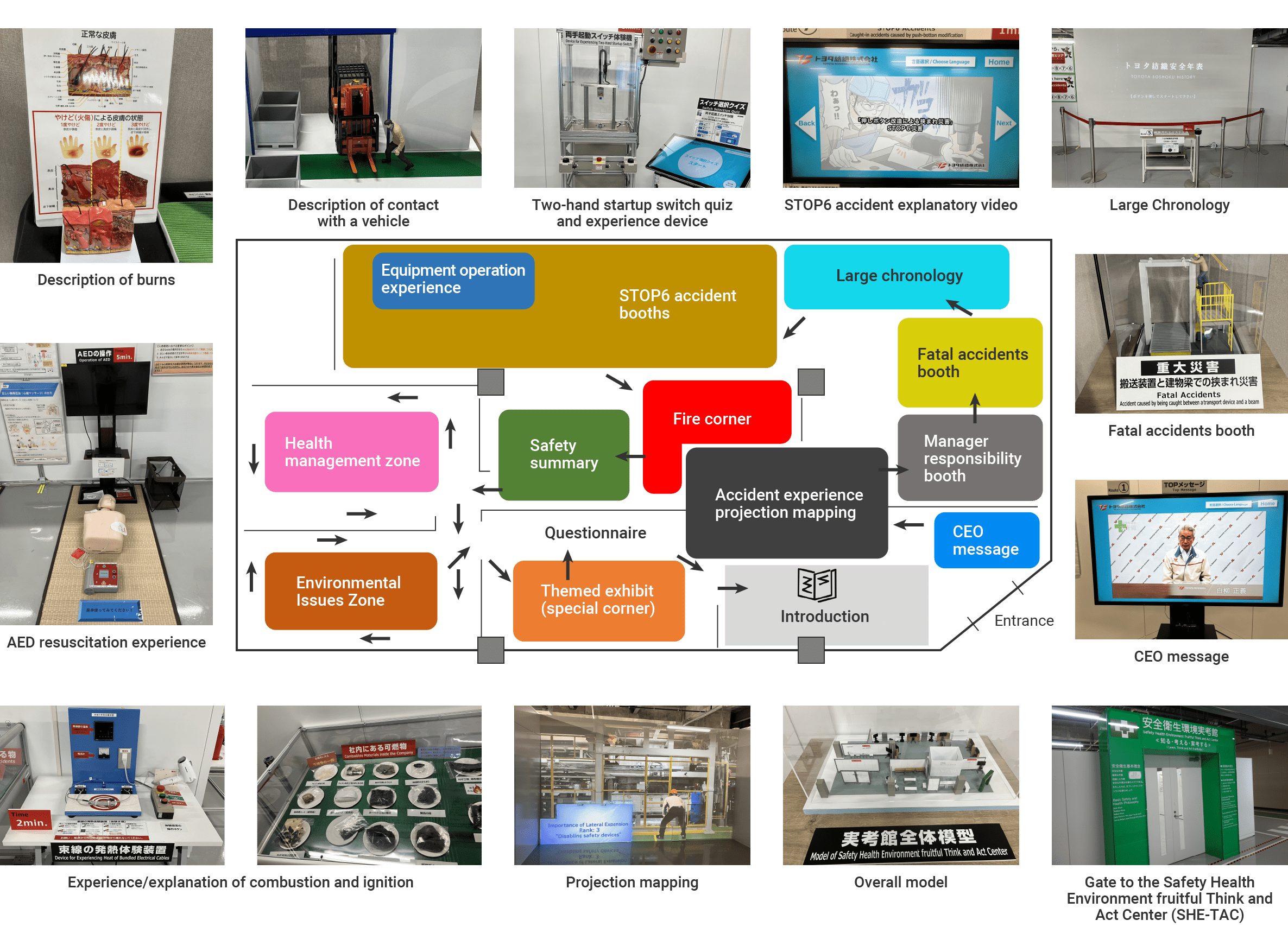
- “Kiken (danger),” “Yochi (prediction),” and “Training”: Training to prevent accidents by predicting potential hazards in advance
- Safety Education Academy for Construction
Ensuring Safety in Outsourced Construction
Toyota Boshoku conducts activities together with the Toyota Boshoku Health and Safety Association (including 47 companies) with the aim of ensuring safe construction management where there is no fatal accident on premises for anyone.
Organizational chart of Toyota Boshoku Health and Safety Association

Outsourced construction patrol
Plant Health & Safety Administration, the Toyota Boshoku Health and Safety Association, and the construction planning division work together as one in outsourced construction patrol activities. Patrols don’t simply involve identifying unsafe behavior, but also listening to concerns, and creating an even better environment for construction workers.
Patrol activities in close collaboration

System for Construction Observer Qualification
Outsourced construction is observed and managed for safety by holders of internal qualifications, each of whom has received specialist training.
Observer training (recalling and reflecting training)
Goal: to improve observers’ awareness of safety-related issues
Result: cultivation of talented personnel with heightened danger awareness, who can identify important issues for contractors and instill caution
- Examples:
-
- Was the number of work supervisor appropriate?
- Were the measures resulting from the risk assessments appropriate?
- Do you know the appropriate way of using this protective equipment?
Safety Education Academy for Construction (SEAC)
The SEAC was launched in order to prevent accidents involving visitors and construction workers at our company sites.
At the SEAC those in charge of construction work are offered the chance to handle equipment identical to those used in real worksites, and so get accustomed to the worksite environment. Participants who undergo this training develop a practical understanding of potential risks, and will be able to identify and perform kaizen on any issues or flaws they may encounter when actually visiting a worksite.
Since fiscal 2024, the training has been provided for our affiliates as well.
Comments from participants
- It was a good experience for me because there are not many hands-on training programs that allow me to see and point out the actual worksite.
- I strongly felt that I had to take into consideration the safety of not only myself, but also of the construction workers and others.
- It was practical and easier to understand than just thinking only in my mind. It was helpful.
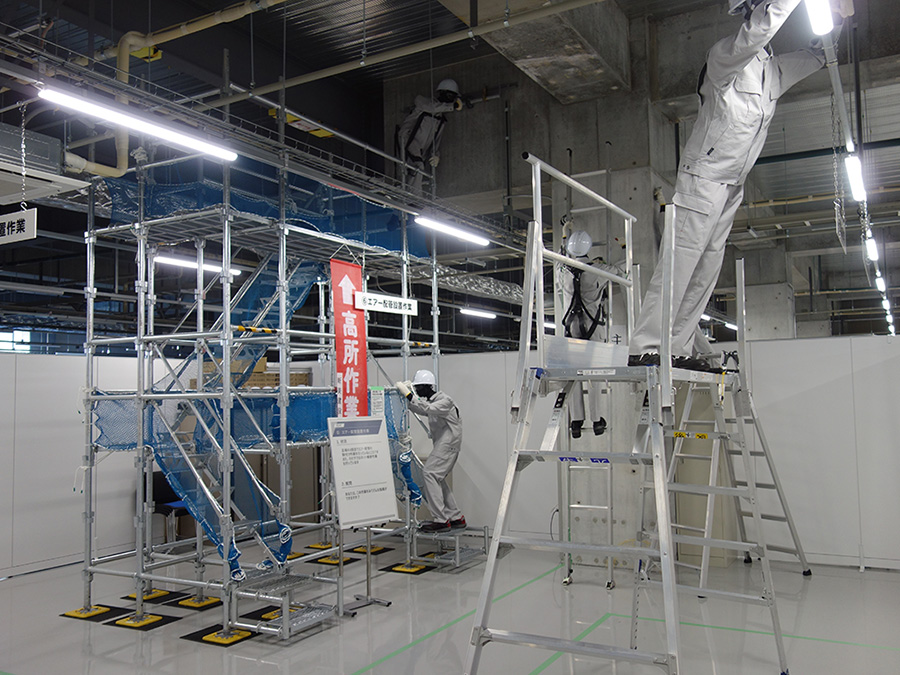
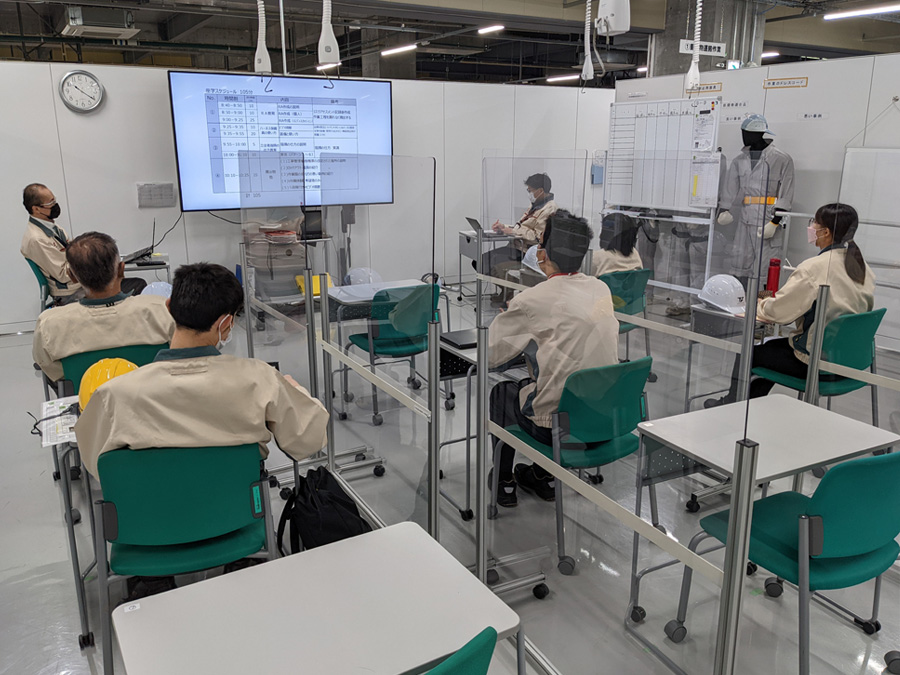
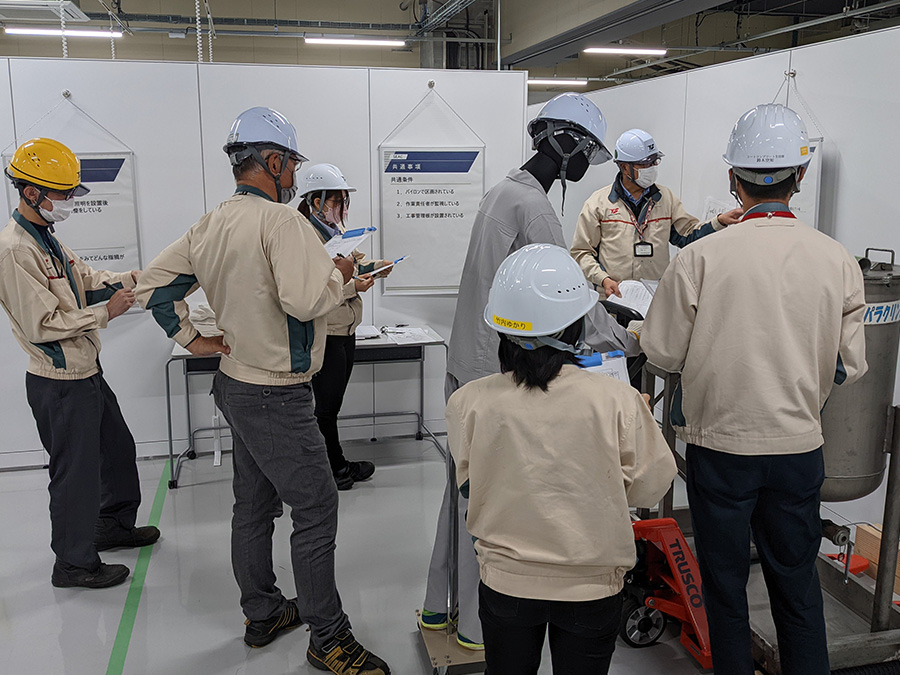
Introduction of Five-step Toolbox Meeting (TBM)
We are introducing Five-step TBM with the aim of preventing accidents resulting from changes during construction or awkward-to-perform work. Toolbox meetings consist of five meetings held throughout the day (after morning greetings, at 10am, after lunch, at 3pm, and after work has finished), which allows confirmation of the contents of work instructions, sources of potential danger, as well as changes to company members’ physical conditions and other similar issues.
Five-step TBM
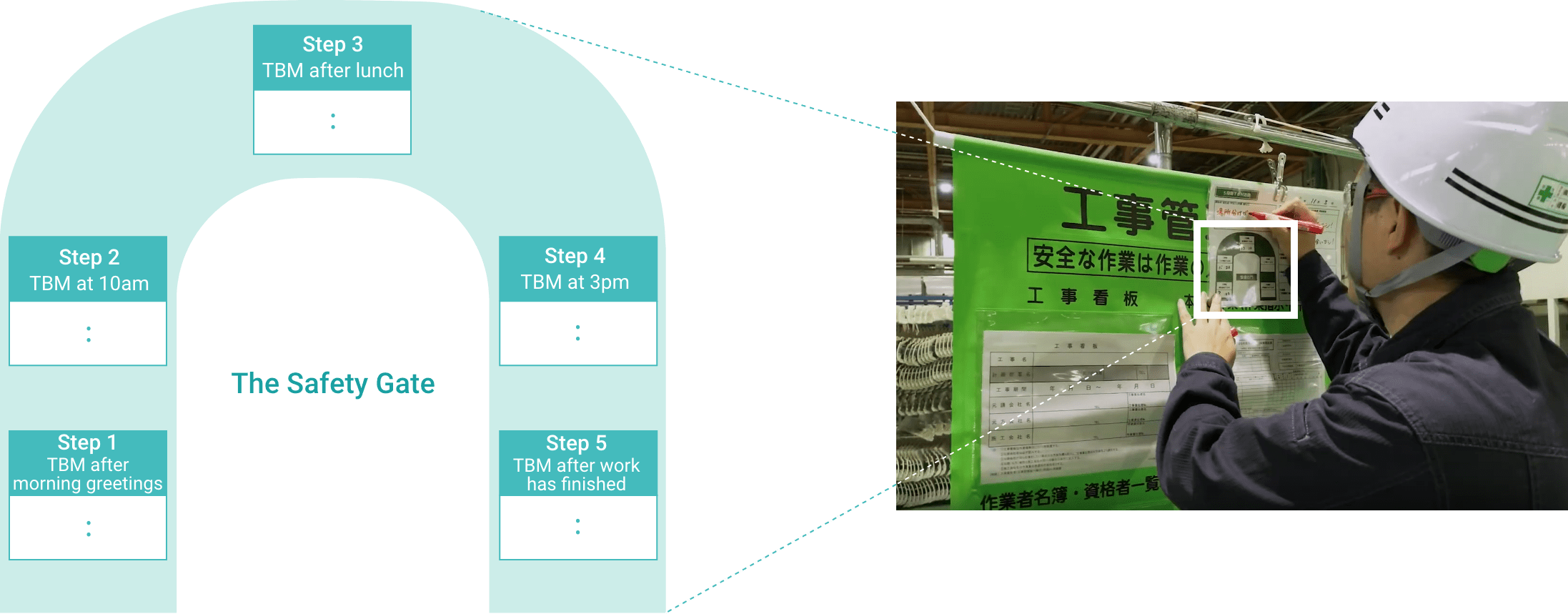
Fire Prevention
Past fires
At 2pm on April 29, 2018, a large-scale fire broke out at Tsutsumi Plant, causing a great deal of trouble and concern for the local community, our business partners and our shareholders. To ensure this kind of issue does not reoccur we hold the worldwide Toyota Boshoku Group Fire Prevention Day annually on April 29.
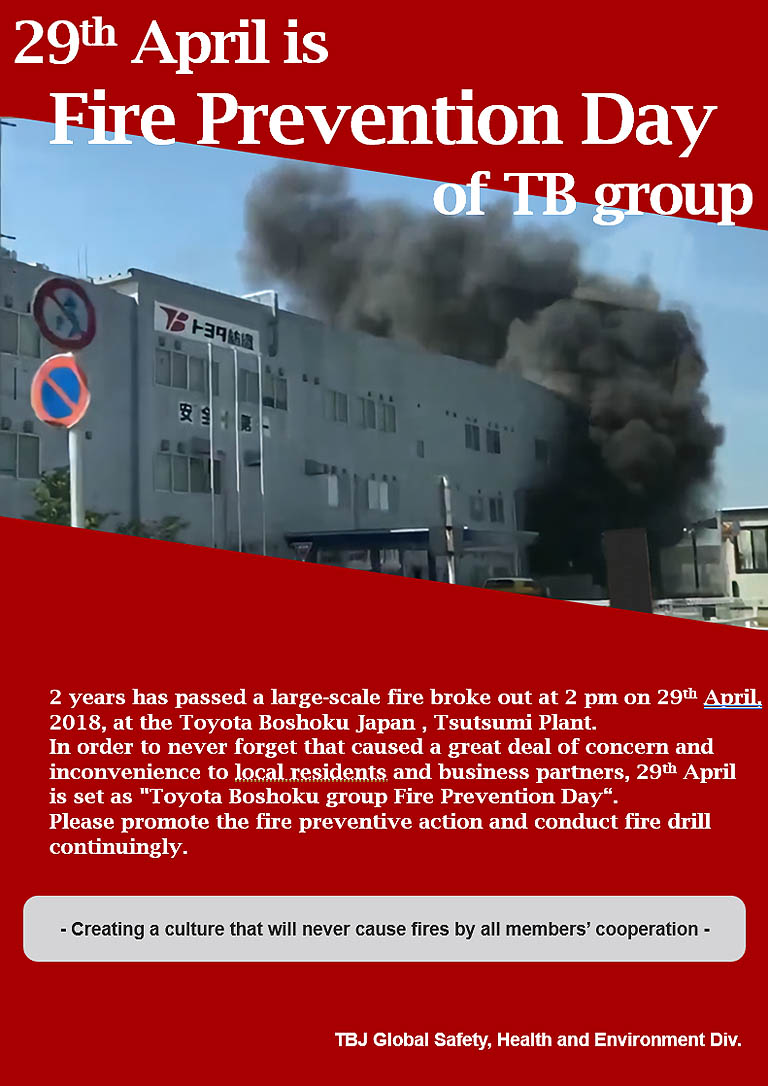
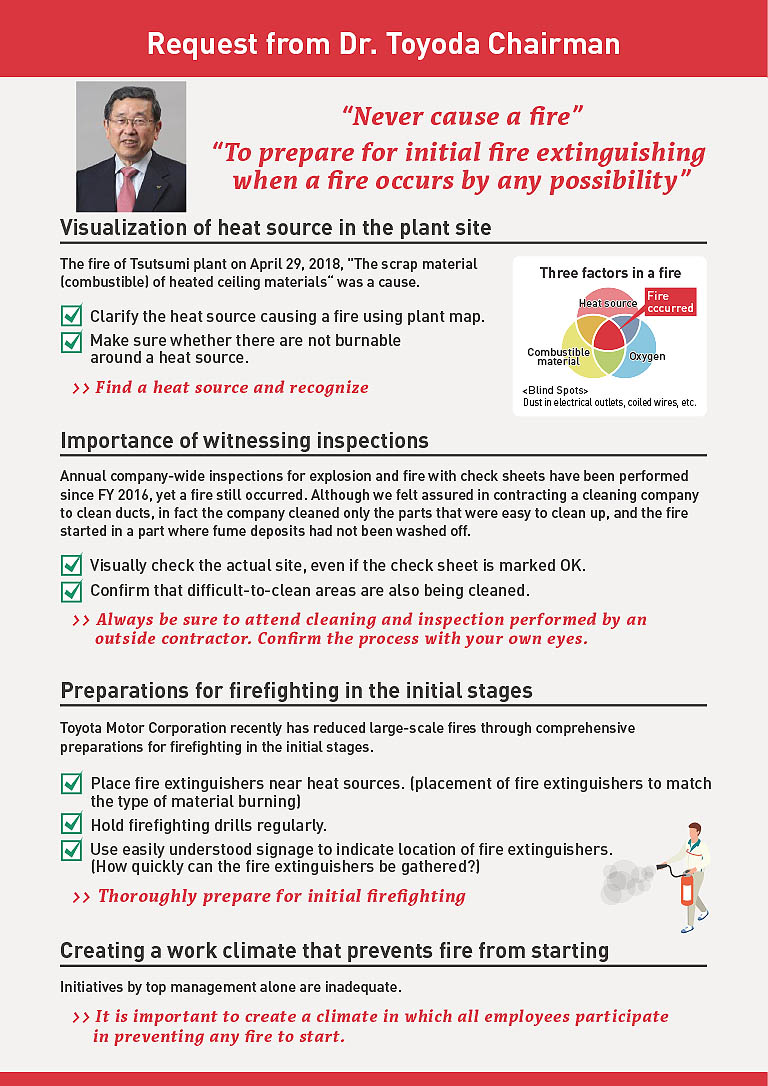
Fire safety inspections performed by top management
In response to the 2018 fire, we have created heat source maps to identify any potential fire origin points. Company presidents and chief plant general managers at all Toyota Boshoku plants, as well as at affiliated companies inside Japan, perform fire safety inspections on a continuous basis to check the handling and conditions of heat sources and other areas of potential danger.
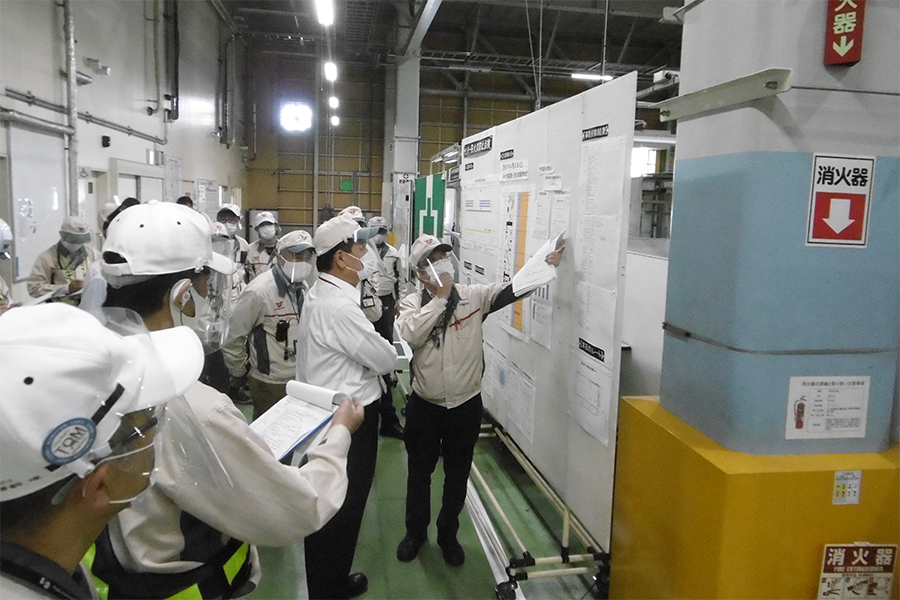
Fire extinguisher training using VR
When performing fire extinguisher training, there is naturally a limit to the number of fire extinguishers that can be made available. However, by making use of VR during training, we are able to increase the number of people participating in this important training.
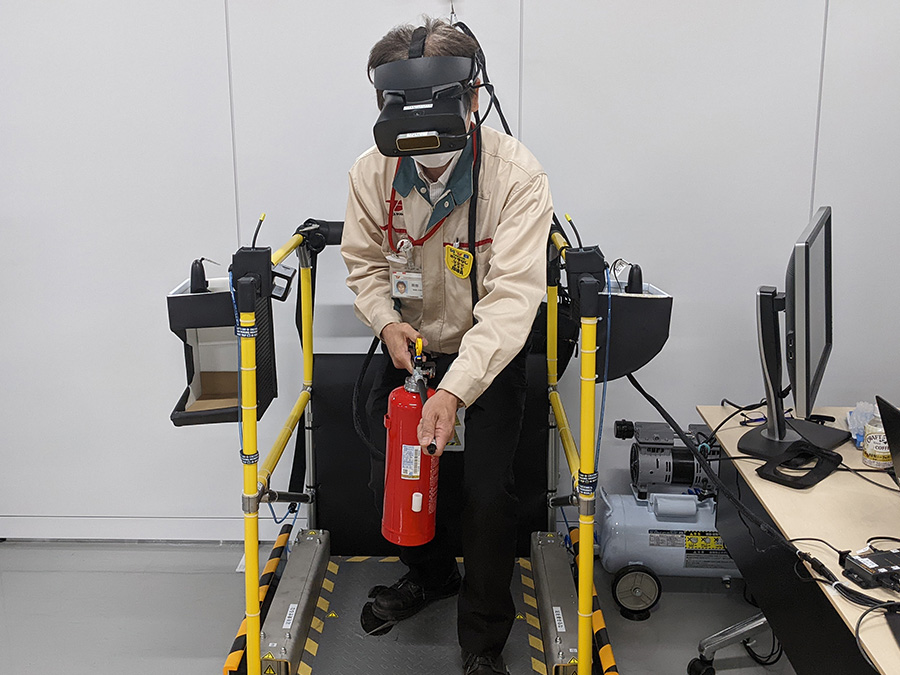
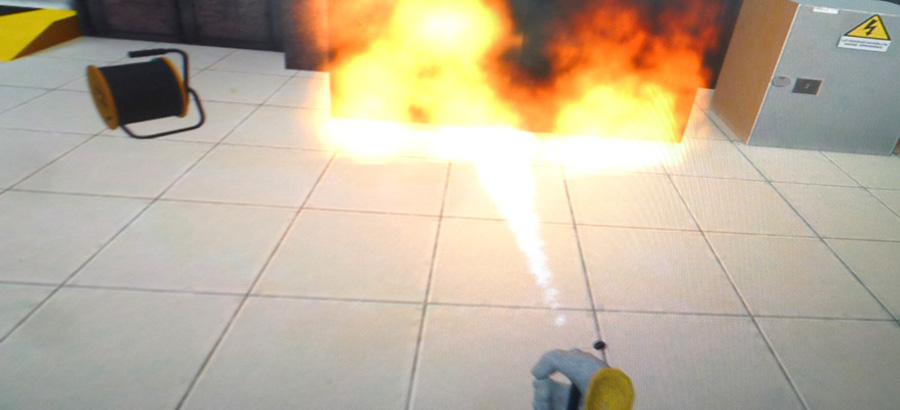
Development of global standards for fire prevention
While the firefighting laws and regulations differ between countries and regions, we have formulated global standards for the management of hazardous materials and fire alarms, etc., based on past cases of fires, in order to conduct fire prevention activities from the same perspective globally. We have also created a fire prevention inspection checklist based on global standards, and the entire Toyota Boshoku group conducts fire prevention inspections.


